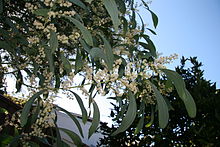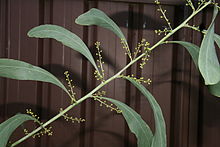- Acacia falcata
-
Acacia falcata Scientific classification Kingdom: Plantae (unranked): Angiosperms (unranked): Eudicots (unranked): Rosids Order: Fabales Family: Fabaceae Genus: Acacia Species: A. falcata Binomial name Acacia falcata
Willd.
Range of Acacia falcata Synonyms Acacia falcata, commonly known as sickle wattle and by other vernacular names including sally,[2] is a perennial shrub or tree native to eastern Australia, which reaches five metres in height and has cream flowers in early winter. It gets its common and scientific name for its sickle-shaped leaves. Hardy and adaptable to cultivation, it is used in regeneration of bushland.
Contents
Taxonomy
German botanist Carl Ludwig Willdenow was the first to officially describe the sickle wattle in 1806,[3] although his countryman Johann Christoph Wendland had given it the name Mimosa obliqua in 1798, this was deemed a nomen illegitimum.[4] The species name is derived from the Latin word falx "sickle". Some common names for it are burra, sally, sickle-shaped acacia and silver-leaved wattle.[1]
Description
Found as a shrub or small tree from 2 to 5 m (7–16 ft) high, Acacia falcata has grey or black bark. Like all wattles it has phyllodes rather than leaves. These are a pale green or grey-green and sickle-shaped, measuring 7–19 cm (2.8–7.6 in) in length, by 0.9–4 cm (0.4–1.6 in) wide with a prominent mid vein. The small round flowers are cream or pale-yellow and appear in early winter from April to August. These are followed by thin seed pods which are 4.5–12 cm (0.8–4.6 in) long and 0.5–0.8 cm (0.2–0.3 in) wide.[5] The pods mature from September to December.[6]
Distribution and habitat
The range is from Queensland south through eastern New South Wales to Bermagui on the south coast.[5] It grows predominantly on shale soils in open forest,[7] and is associated with such trees as Eucalyptus paniculata, E. longifolia and E. tereticornis.[8] Naturalised, it has been recorded in Java in Indonesia, and in North Island in New Zealand.[1]
Ecology
Plants live for five to twenty years in the wild, and are killed by bushfire. The seed is released in December, and dispersed by wind. It is stored in the soil, although it is unclear how related germination is to bushfire. Seed can germinate in disturbed areas.[8]
Acacia falcata is the host plant for the Imperial Hairstreak (Jalmenus evagoras).[9] One field study recovered 98 species of bug (hemiptera) from A. falcata across its range.[10]
Cultivation and uses
Acacia falcata is adaptable to a wide range of soils in cultivation, and its attractive foliage is a horticultural feature.[6] It is propagated by seed which must be pretreated with boiling water before it is able to germinate. It is easy to grow given a good sunlit position and good drainage, and is used in revegetation.[11]
Australian indigenous people use the bark to make a liniment for treating ailments of the skin.[12] A. falcata is excellent for stabilizing barren sand. The bark is important in the tanning industry.[13]
References
- ^ a b c "Acacia falcata". ILDIS LegumeWeb. International Legume Database & Information Service. 2010. http://www.ildis.org/LegumeWeb?version~10.01&LegumeWeb&tno~19913&genus~Acacia&species~falcata. Retrieved 17 August 2011.
- ^ A sallow is a shrubby willow (OED).
- ^ "Acacia falcata Willd.". Australian Plant Name Index (APNI), IBIS database. Centre for Plant Biodiversity Research, Australian Government. http://www.anbg.gov.au/cgi-bin/apni?taxon_id=8349.
- ^ "Mimosa obliqua J.C.Wendl.". Australian Plant Name Index (APNI), IBIS database. Centre for Plant Biodiversity Research, Australian Government. http://www.anbg.gov.au/cgi-bin/apni?taxon_id=19934.
- ^ a b New South Wales Flora Online: Acacia falcata by PG Kodela, Royal Botanic Gardens & Domain Trust, Sydney, Australia
- ^ a b Eliot RW, Jones DL, Blake T (1985). Encyclopaedia of Australian Plants Suitable for Cultivation. 2. Port Melbourne: Lothian Press. pp. 48–49. ISBN 0-85091-143-5.
- ^ Fairley A, Moore P (2000). Native Plants of the Sydney District: An Identification Guide (2nd ed.). Kenthurst, NSW: Kangaroo Press. p. 128. ISBN 0-7318-1031-7.
- ^ a b Benson, Doug; McDougall, Lyn (1996). "Ecology of Sydney Plant Species Part 4: Dicotyledon family Fabaceae". Cunninghamia 4 (4): 552–752. ISSN 0727-9620. http://www.rbgsyd.nsw.gov.au/__data/assets/pdf_file/0006/57849/Cun4Ben552.pdf.
- ^ A. Wells, W. W. K. Houston (2001). Hesperioidea, Papilionoidea. Collingwood, Victoria: CSIRO Publishing. pp. 264. ISBN 0643067000. http://books.google.com.au/books?id=iVHDuVVelGMC&pg=PA264&lpg=PA264&dq=%22Acacia+falcata%22+lepidoptera&source=bl&ots=sa7IoHw9gq&sig=Ta1A5hn4iuesSgGDLqRzmU7e9nw&hl=en&ei=gsFLTvrcNY_ViALywoWgAQ&sa=X&oi=book_result&ct=result&resnum=5&ved=0CD4Q6AEwBA#v=onepage&q=%22Acacia%20falcata%22%20lepidoptera&f=false.
- ^ Andrew, Nigel R.; Hughes, Lesley (2005). "Diversity and assemblage structure of phytophagous Hemiptera along a latitudinal gradient: predicting the potential impacts of climate change". Global Ecology and Biogeography 14: 249–62. http://www.une.edu.au/esnrm/pdf/GEB_14_249.pdf.
- ^ Wrigley, John; Fagg, Murray (1996). "Acacia falcata". Canberra, ACT: Australian National Botanic Gardens. http://www.anbg.gov.au/acacia/species/A-falcata.html. Retrieved 17 August 2011.
- ^ Robinson, Les (1993). "Aboriginal Uses of Plants Around Sydney". http://farrer.csu.edu.au/ASGAP/APOL10/jun98-6.html. Retrieved 17 August 2011.
- ^ Ferdinand von Mueller (1884). Select Extra-tropical Plants Readily Eligible for Industrial Culture Or Naturalization: with indications of their native countries and some of their uses. G.S. Davis. p. 5. http://books.google.com/books?id=9du2A0jbJMAC&pg=PA5&lpg=PA5&ots=dMyaQEsM_J&dq=%22acacia+falcata%22+uses&ie=ISO-8859-1.
Categories:- Acacia
- Fabales of Australia
- Trees of New Zealand
- Trees of Australia
- Flora of New South Wales
- Flora of Queensland
- Shrubs
Wikimedia Foundation. 2010.


